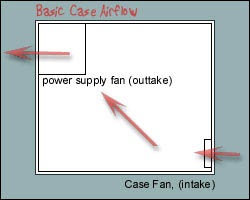|
Hardcore
case cooling is often depicted as drilling extra holes throughout
your case, in order to get better airflow. While often times
this is the most effective way of cooling your case, and obtaining
good airflow, its not easy and sometimes its not something your
average user wants to do. Just because you don't want to drill
holes in your case, doesn't mean that your case can't be cool.
The cooling system built in this guide provides a cool 28 -
32c case temp, even during the longest quake playing sessions.

Creating
an Airflow
The first big step in cooling your case is getting an intake
fan. This fan will sit in the very front of your case, sucking
in cool air from the outside of your case and dispersing it
with-in. This is the first step in creating a steady airflow.
The general rule of case cooling is this; bring air in the bottom
front of your case, and blow it out at the rear top. Since heat
rises, all the heat from your components should gather near
the top, and hopefully sucked out. While the best way to suck
the hot air out is creating a blowhole, most power-supply's
does have a fan that sucks air out. This works well enough for
the average user, and it does create steady airflow. For best
cooling performance, using any fan smaller than 80mm is not
recommended. Standard 80mm fans push 30 - 40cfm of air, while
larger 120mm fans general push 75 - 140cfm.

(red
arrow = air flow)
Next
>>
|